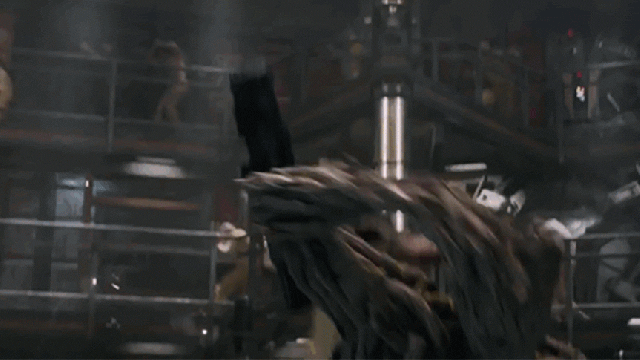It’s commonly known as the “sports effect”, the “soap opera effect”, “motion smoothing” or “motion interpolation”, and it makes sports on your TV look great, while movies look… weird. TV manufacturers turn this setting on by default and all too often it just gets left that way. Now, James Gunn is getting his Hollywood buddies to help rally against it.
GIF Source: Marvel Studios
[referenced url=”https://gizmodo.com.au/2017/09/why-youre-watching-tv-all-wrong-and-how-to-fix-it/” thumb=”https://i.kinja-img.com/gawker-media/image/upload/t_ku-large/ir6jatqekn931resfp7u.jpg” title=”Why You’re Watching TV All Wrong, And How To Fix It” excerpt=”If you’re going to invest hundreds of dollars on a television set then you want to make sure you’re setting the best picture possible, but far too many of us don’t take the time to correctly configure the display we’re staring at. Here’s how to get your money’s worth from your TV tech and the on-screen settings you need to know about.”]
Yesterday, the Guardians of the Galaxy director tweeted, “So @rianjohnson, @edgarwright, @mattreevesLA, @chrismcquarrie, @TomCruise & I are all on board the anti-motion-smoothing campaign. Who else?” In order, the people Gunn identified as joining him are the directors of The Last Jedi, Baby Driver, War of the Planet of the Apes, the latest Mission Impossible, and then there’s Tom Cruise.
Christopher McQuarrie quickly jumped in with some Ice Bucket Challenge-style provocation and nominated James Cameron and Michael Bay to join the campaign. (They haven’t at time of writing.) 10 Cloverfield Lane director Dan Trachtenberg added his support, and tweeted, “please make this official.” And Reed Morano, director of several episodes of The Handmaid’s Tale, pointed out that she’s been trying to do something about motion smoothing for a long time.
Been at it for years. Sux. https://t.co/MCFLQHCsPh
— Reed Morano, A.S.C. (@reedmorano) October 5, 2017
If you’re not entirely sure what these folks are going on about, motion smoothing is a feature on most modern TVs that intended to correct hi-def screens’ tendency to make objects in motion appear to be blurry. In order to do this, the TV processes one frame, then the next, and makes a guess on what a new frame that goes between them should look like. This can be very helpful if you’re watching a football game, for example, and you’re attempting to keep track of the ball in a wide landscape shot. It gives everything a crisp edge. The feature can also be good for upping video game frame rates, but it will get you killed because it introduces extra lag.
Most movies are still shot at 24 frames per second these days, and when the motion smoothing is enabled on a TV it causes things to look unnatural, or for some people too natural. The lovely cinematography that the filmmakers worked to craft starts to get that low budget look of television soap operas, and the actors look a little too real. Peter Jackson’s The Hobbit received a lot of criticism for its look and was often said to look like it was being shown on a TV that accidentally had the motion smoothing setting turned on. But in reality, The Hobbit looked that way because it was shot and projected at 48 frames-per-second. Whether you like it or not, that’s the look Peter Jackson wanted.
The filmmakers that take issue with motion smoothing are primarily annoyed that televisions almost always have this setting turned on by default. Manufacturers have their reasons for this — it makes a TV in the showroom extra stimulating for one. Many people don’t know that they shouldn’t use this setting for every kind of programming, and the fact that different manufacturers have different terminology for their settings makes it more difficult to educate people. As Rian Johnson pointed out to one Twitter commenter who was saying people can just turn it off, the menu settings can be pretty difficult to navigate for a novice. “MENU>PICTURE>ADVANCED CONTROLS>REALITY AUGMENTATION>MOTION LIQUIDITY>FLUID FRAME RESTORATION,” he explained is not a simple series of steps, just try saying “reality augmentation” to your grandmother. “You want movies to look like liquid diarrhea, fine,” Johnson wrote. “But it should be a choice you make, not a hoop everyone has to jump through to unmake.”
Other famous people such as Peyton Reed, director of Ant-Man, have been jumping into the thread to show their support. And when someone suggested Christopher Nolan, McQuarrie replied that he shares a producer with the filmmaker and “It’s tomorrow’s first bit of business”. Nolan is a good choice because he’s such an old-school guy who still insists on shooting with film and is a notorious stickler for having his films shown as they were intended. It would be even better to gather the support of someone with a broader influence in business — someone like Steven Spielberg. And executives at Sony Films could have a direct influence on their company’s TV biz.
All that really needs to be done is simplifying the ways that modes can be changed. And when the TV is first booted up, it should explain what the differences are. These industry folks are in a position to make your trip to grandpa’s house less frustrating if they take their efforts beyond clicktivism.
[James Gunn via Polygon]
